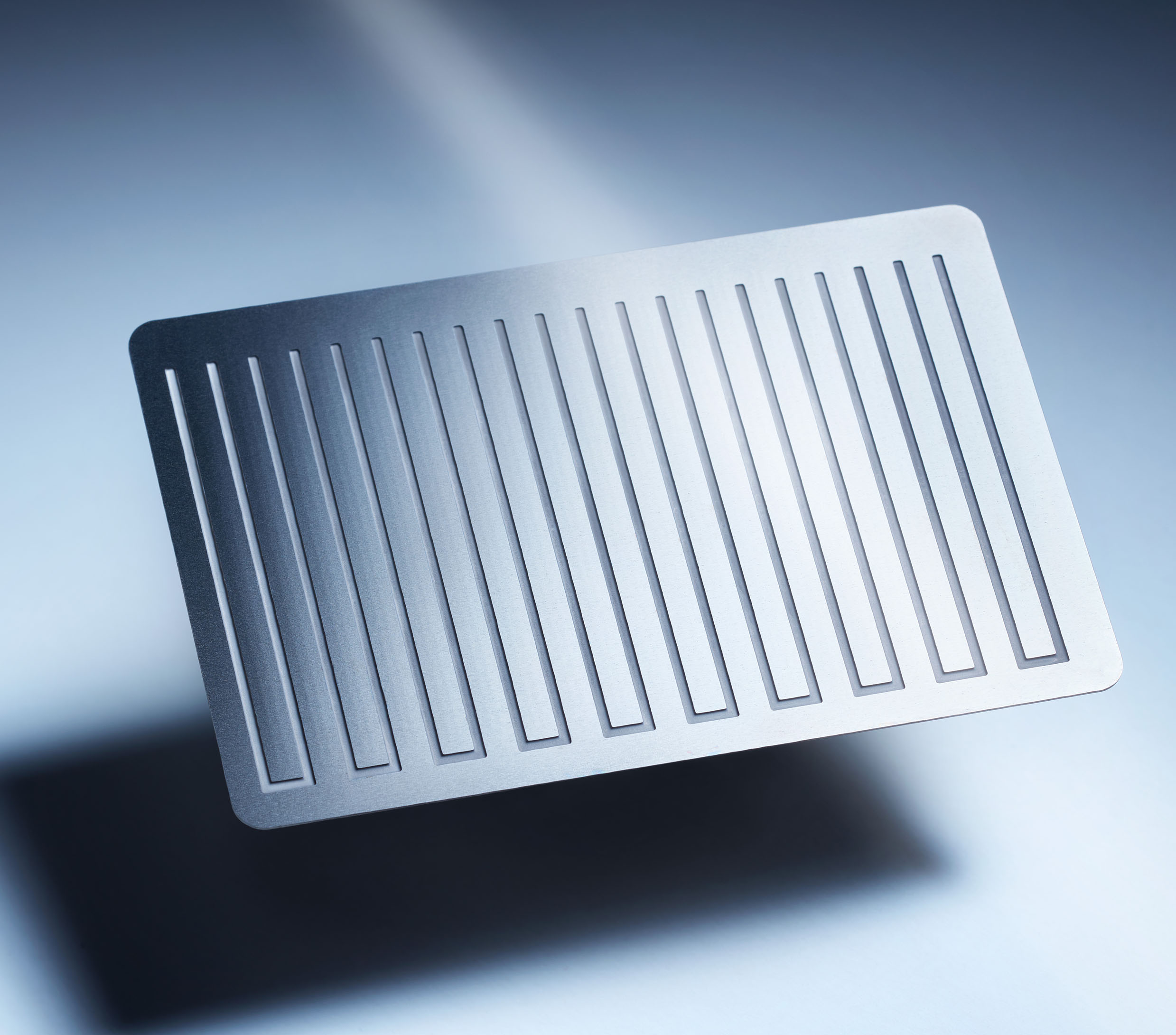
Plate heat exchangers are found in numerous industrial applications and essentially use metal plates to transfer heat between two fluids.
Their use is burgeoning as they out-perform conventional heat exchangers (often a coiled pipe containing one fluid that passes through a chamber containing another fluid) as the fluids being cooled are in contact with a much greater surface area, which optimizes the transfer of heat and greatly increases the speed of temperature change.
Plate heat exchangers
In place of the coiled pipe passing through a chamber, in plate heat exchangers there are instead two alternating chambers, usually thin in depth, separated at their largest surface by a corrugated metal plate. The chambers are thin as this ensures that most of the volume of the liquid contacts the plate aiding heat exchange.
Such heat exchange plates were traditionally made using stamping or conventional machining like deep drawing, but more recently photo-chemical etching (PCE) is proving itself to be the most efficient and cost-effective manufacturing technology available for this exacting application. Electrochemical machining (ECM) is another alternative technology and can make very precise parts at volume, but this process requires very high levels of up-front investment, is restricted to conductive materials, uses a lot of energy, design, and fabrication of tools is difficult, and corrosion of the workpiece machine tool, and fixtures re a constant headache.
Often both sides of plate heat exchangers contain extremely complex features which are sometimes beyond the ability of stamping and machining but are easily achieved using PCE. In addition, PCE can produce features on both sides of the plate simultaneously saving significant amounts of time, and the process can be applied to a range of different metals including stainless steel, Inconel 617, aluminum, and titanium.
Process advantages
PCE provides an attractive alternative to stamping and machining in plate applications due to some inherent characteristics of the process. Using photoresists and etchants to chemically machine selected areas accurately, the process is characterized by retention of material properties, burr-free and stress-free parts with clean profiles, and no heat-affected zones. In addition, the fluid etching media creates optimal structures for fluid cooling media used in the plates. These structures do not have corners ad edges that can be susceptible to corrosion.
Coupled with the fact that PCE uses easily re-iterated and low-cost digital or glass tooling, it provides a cost-effective, highly accurate, and speedy manufacturing alternative to traditional machining technologies and stamping. This means that there are significant savings when producing prototype tools, and unlike stamping and machining technologies, there is no tool wear and costs associated with recutting steel.
Machining and stamping can produce less than perfect effects in metal at the cut line, often deforming the material being worked, and leaving burrs, heat-affected zones, and recast layers. In addition, they struggle to meet the detail resolution required in ever smaller, more complex, and more precise metal parts like heat exchange plates.
Another factor to consider in process selection is the thickness of the material to be worked. Traditional processes tend to struggle when applied to the working of thin metals, stamping and punching being inappropriate in many instances, and laser and water cutting causing disproportionate and unacceptable degrees of heat distortion and material shredding respectively. While PCE can be used on a variety of metal thicknesses, one key attribute is that it can work on thinner metal sheets like those used in plate heat exchangers without compromising flatness, which is vital for component integrity.
Applications
One key area in which plates are used is in fuel cell applications made from stainless steel, aluminum, nickel, titanium, copper, and a range of exotic alloys.
It is found that metallic plates in fuel cells offer numerous advantages over other materials. They are at the same time extremely robust, provide excellent conductivity for better cooling, can be made extremely thin using etching producing shorter stacks, and there is no directional surface finish within the channels. The plates can be profiled and channels generated at the same time, and as mentioned, there is no thermal stress induced in the metal ensuring absolute flatness.
The PCE process ensures reproducible tolerances on all critical plate dimensions, including gas track depth and manifold geometry, and can manufacture parts to stringent pressure-drop specifications.
Other sectors that have applications using chemically etched plates include the linear motor, aerospace, petrochemical, and chemical industries. Once manufactured, the plates are stacked and diffusion bonded or brazed together to make the core of the heat exchanger. The finished heat exchangers can be up to six times smaller than traditional “shell and tube” heat exchangers delivering excellent space and weight benefits.
Heat exchangers produced using PCE are also extremely robust and efficient and can have a pressure capability of 600 bar while accommodating temperatures ranging from cryogenic to 900 degrees C. More than two process streams can be incorporated into a single unit and the requirement for piping and valves is greatly reduced. Reaction and mixing can also be incorporated into the plate heat exchanger design, cost-effectively increasing functionality in a single unit.
Summary
Today's requirements for efficient and space-saving heat dissipation pose great challenges for many development engineers. The miniaturization of many components in electrical and micro-system technology creates so-called heat hotspots, which require optimal heat dissipation to ensure long service life.
Using 2D and 3D PCE allows the manufacture of micro-channels with a defined width and depth in heat exchangers for the heat-dissipating media of choice in the smallest of areas. There are almost no limits to the design of the channels possible.
In addition, as the etching process stimulates design innovation and geometric freedom, turbulent flow as opposed to laminar flow can be promoted through the use of wavy channel edges and depths. Turbulence in the cooling media means that the coolant in contact with the heat source is constantly changing, and this makes heat exchange more efficient. Such waviness and irregularities in the micro channels in a heat exchanger are easy to produce via PCE but are either impossible or cost-prohibitive to produce using alternative fabrication processes.
PCE expert micrometal GmbH uses competitively priced photo-optical tools to produce high-quality workpieces with highly repeatable accuracy.
The individual microchannel plates can be connected — for example by diffusion welding — to a variety of 3D geometries. micrometal uses an experienced network of partners, which gives customers the choice of purchasing individual micro-channel plates or monolithic micro-channel heat exchanger blocks.
Contact Details
Related Glossary Terms
- alloys
alloys
Substances having metallic properties and being composed of two or more chemical elements of which at least one is a metal.
- coolant
coolant
Fluid that reduces temperature buildup at the tool/workpiece interface during machining. Normally takes the form of a liquid such as soluble or chemical mixtures (semisynthetic, synthetic) but can be pressurized air or other gas. Because of water’s ability to absorb great quantities of heat, it is widely used as a coolant and vehicle for various cutting compounds, with the water-to-compound ratio varying with the machining task. See cutting fluid; semisynthetic cutting fluid; soluble-oil cutting fluid; synthetic cutting fluid.
- diffusion
diffusion
1. Spreading of a constituent in a gas, liquid or solid, tending to make the composition of all parts uniform. 2. Spontaneous movement of atoms or molecules to new sites within a material.
- electrochemical machining ( ECM)
electrochemical machining ( ECM)
Operation in which electrical current flows between a workpiece and conductive tool through an electrolyte. Initiates a chemical reaction that dissolves metal from the workpiece at a controlled rate. Unlike with traditional cutting methods, workpiece hardness is not a factor, making ECM suitable for difficult-to-machine materials. Takes such forms as electrochemical grinding, electrochemical honing and electrochemical turning.
- linear motor
linear motor
Functionally the same as a rotary motor in a machine tool, a linear motor can be thought of as a standard permanent-magnet, rotary-style motor slit axially to the center and then peeled back and laid flat. The major advantage of using a linear motor to drive the axis motion is that it eliminates the inefficiency and mechanical variance caused by the ballscrew assembly system used in most CNC machines.
- waviness
waviness
The more widely spaced component of the surface texture. Includes all irregularities spaced more widely than the instrument cutoff setting. See flows; lay; roughness.


